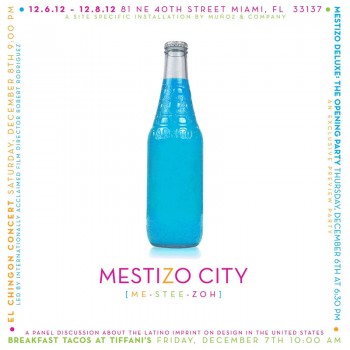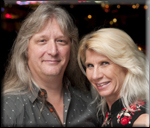Henry R. Muñoz III Presents Mestizo City During Art Basel Miami Beach
 December 7 – 8, 11:00AM to 6:00PM.
December 7 – 8, 11:00AM to 6:00PM.
Miami Design District
81 NE 40th Street
Miami, FL
A leading voice for Latinos in American culture, Henry R. Muñoz III, envisions a Latino imprint on U.S. culture and design.
Mestizo Deluxe: On Thursday, December 6, from 6:30-10PM, guests will be invited to ‘Mestizo Deluxe’ a private preview and opening party for Mestizo City. Guests will experience the cultural phenomenon of multi-sensory celebration within public spaces inherent in Latino culture.
Breakfast Tacos at Tiffani’s: On Friday, December 7 at 10:00am, enveloped in Robin’s Egg blue and wrapped in a white satin ribbon, patrons and press are invited to a discussion about Mestizo Style. The discussion will be moderated by acclaimed journalist Fred Bernstein, a frequent contributor to publications including The New York Times, Departures and Architectural Record. Panelists include Henry R. Muñoz III, CEO of Muñoz & Company, Geoffrey S. Edwards, COO and Principal of Muñoz & Company, activist and a pioneering scholar of Chicano and US Latino art, Dr. Tomás Ybarra-Frausto and Lowery Stokes Sims, Curator, Museum of Arts and Design.
“Have you been to Mestizo City?†On Saturday, December 8, at 9:00PM the evening will feature a celebration of the Mestizo design aesthetic featuring a concert by El Chingon; the band led by internationally acclaimed film director Robert Rodriguez of “Machete†“Spy Kids†and “Sin City†fame.
Mestizo City, a 6,700 square-foot site-specific installation, is a playful interactive public space, created to represent the vibrant and varied Latino culture and its growing influence in the United States. Created by Henry R. Muñoz III, a San Antonio-based designer and social activist in the Miami Design District during Art Basel Miami Beach 2012. Mestizo City will be on view and open to the public.
In the wake of the Presidential election, which marked the historic Latino impact on the election outcome, Mestizo City in a timely way explores the demographic shift, taking place in the United States. The installation incorporates and wittily reinterprets some of the most recognizable visual and social elements associated with the Latino culture: inflatable structures, a taco truck, Jarritos bottles, bright colors, informal concepts of space and street art.
“Mestizo City asserts and celebrates the idea that you cannot build a wall between culture and creativity—and that physical borders cannot fracture the growing influence of Latinos in the United States. This installation reclaims and re-imagines an unexpected urban location to create a public space that promotes ideas of Latino Urbanism and the Mestizaje†says Muñoz.
Visitors to Mestizo City will enter through one of four vinyl-coated nylon inflatable storefronts, evocative of inflatable playscapes – a long-standing symbol of street corner entrepreneurship in the Latino culture. The storefronts represent the current obsession with global consumerism while serving as the backdrop for the commercial and social interactions inside the site.
Once visitors have crossed the “border,†they will enter the town center. The focal point of Mestizo City, is Jarritos Cube. The 12x12x12-foot illuminated cube, composed of the iconic Mexican soda bottle, explores the idea of informal architecture by using a non-traditional building material to create a formal structure.
An 8-foot tall Photo Wall will showcase a series of printed photographs mounted to the perimeter walls of Mestizo City using wheat paste. A makeshift urban gallery, the photos were collected by Friends of the National Museum of the American Latino through social media from people all across the nation. They exemplify the cultural phenomenon of Mestizaje in the built environment, such as images of houses painted with bright colors and makeshift fruit markets set up in front of tire shops. These photos intermix with images of Muñoz & Company’s work that employ the same ideas and concepts.
The Taco Truck serves as a meeting place for visitors, where they can eat, drink, and generally taste Latino culture. It explores the idea of transforming empty lots and other unexpected locations into temporary, vibrant social spaces.
The Map/Infographic serves as a visual representation of information and data regarding to Latino population in the United States. Composed of coffee, pinto and black beans, it depicts the map of the United States, indicating the Latino population of each state through density of the beans.

